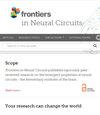Acetylcholine facilitates localized synaptic potentiation and location specific feature binding
IF 3.4
3区 医学
Q2 NEUROSCIENCES
引用次数: 0
Abstract
Forebrain acetylcholine (ACh) signaling has been shown to drive attention and learning. Recent experimental evidence of spatially and temporally constrained cholinergic signaling has sparked interest to investigate how it facilitates stimulus-induced learning. We use biophysical excitatory-inhibitory (E-I) multi-module neural network models to show that external stimuli and ACh signaling can mediate spatially constrained synaptic potentiation patterns. The effects of ACh on neural excitability are simulated by varying the conductance of a muscarinic receptor-regulated hyperpolarizing slow K+ current (m-current). Each network module consists of an E-I network with local excitatory connectivity and global inhibitory connectivity. The modules are interconnected with plastic excitatory synaptic connections, that change via a spike-timing-dependent plasticity (STDP) rule. Our results indicate that spatially constrained ACh release influences the information flow represented by network dynamics resulting in selective reorganization of inter-module interactions. Moreover the information flow depends on the level of synchrony in the network. For highly synchronous networks, the more excitable module leads firing in the less excitable one resulting in strengthening of the outgoing connections from the former and weakening of its incoming synapses. For networks with more noisy firing patterns, activity in high ACh regions is prone to induce feedback firing of synchronous volleys and thus strengthening of the incoming synapses to the more excitable region and weakening of outgoing synapses. Overall, these results suggest that spatially and directionally specific plasticity patterns, as are presumed necessary for feature binding, can be mediated by spatially constrained ACh release.乙酰胆碱促进局部突触增强和位置特异性特征结合
前脑乙酰胆碱(ACh)信号传导已被证明可以驱动注意力和学习。最近的实验证据表明,空间和时间限制胆碱能信号引发了研究它如何促进刺激诱导学习的兴趣。我们使用生物物理兴奋-抑制(E-I)多模块神经网络模型来证明外部刺激和乙酰胆碱信号可以介导空间受限的突触增强模式。通过改变毒蕈碱受体调节的超极化慢K+电流(m电流)的电导来模拟乙酰胆碱对神经兴奋性的影响。每个网络模块由一个具有局部兴奋性连接和全局抑制性连接的E-I网络组成。这些模块与可塑性兴奋性突触连接相互连接,这种连接通过峰值时间依赖的可塑性(STDP)规则变化。我们的研究结果表明,空间约束的ACh释放影响以网络动力学为代表的信息流,导致模块间相互作用的选择性重组。此外,信息流取决于网络中的同步水平。对于高度同步的神经网络,更容易兴奋的模块会引发不太容易兴奋的模块,导致前者的外向连接加强,而其传入突触减弱。对于具有更嘈杂的放电模式的网络,高乙酰氨基酚区域的活动容易诱导同步齐射的反馈放电,从而加强传入突触到更兴奋的区域,减弱传出突触。总的来说,这些结果表明空间和方向特异性的可塑性模式,作为特征结合的必要条件,可以通过空间约束的乙酰胆碱释放介导。
本文章由计算机程序翻译,如有差异,请以英文原文为准。
求助全文
约1分钟内获得全文
求助全文
来源期刊

Frontiers in Neural Circuits
NEUROSCIENCES-
CiteScore
6.00
自引率
5.70%
发文量
135
审稿时长
4-8 weeks
期刊介绍:
Frontiers in Neural Circuits publishes rigorously peer-reviewed research on the emergent properties of neural circuits - the elementary modules of the brain. Specialty Chief Editors Takao K. Hensch and Edward Ruthazer at Harvard University and McGill University respectively, are supported by an outstanding Editorial Board of international experts. This multidisciplinary open-access journal is at the forefront of disseminating and communicating scientific knowledge and impactful discoveries to researchers, academics and the public worldwide.
Frontiers in Neural Circuits launched in 2011 with great success and remains a "central watering hole" for research in neural circuits, serving the community worldwide to share data, ideas and inspiration. Articles revealing the anatomy, physiology, development or function of any neural circuitry in any species (from sponges to humans) are welcome. Our common thread seeks the computational strategies used by different circuits to link their structure with function (perceptual, motor, or internal), the general rules by which they operate, and how their particular designs lead to the emergence of complex properties and behaviors. Submissions focused on synaptic, cellular and connectivity principles in neural microcircuits using multidisciplinary approaches, especially newer molecular, developmental and genetic tools, are encouraged. Studies with an evolutionary perspective to better understand how circuit design and capabilities evolved to produce progressively more complex properties and behaviors are especially welcome. The journal is further interested in research revealing how plasticity shapes the structural and functional architecture of neural circuits.
 求助内容:
求助内容: 应助结果提醒方式:
应助结果提醒方式:


